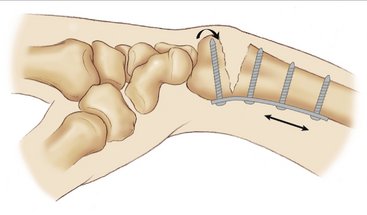CHAPTER 13 Volar Plate Fixation
Fractures of the distal end of the radius have been estimated to account for nearly 20% of all fractures seen routinely in an emergency department.1 Despite this, until very recently the distal radius fracture was not treated as aggressively as other less common periarticular fractures. Perhaps Abraham Colles’ perception that this fracture had good outcomes no matter what was done had permeated our thinking. The reality is that frequent poor outcomes in wrist injury fueled a gradual, albeit delayed, pursuit of a better treatment option.2
Rationale and Basic Biomechanics
Although the concept of volar plating could be initially attributed to Lanz and Kron3 back in 1976 for plate fixation after osteotomy of malunited distal radius fractures, the volar approach remained restricted to fixation of volar rim fractures in the acute setting only.4 Volar plating was first recommended for fixation of both typical and atypical distal radius fractures by Georguoulis and associates in 1992.5 This was published in a little-known journal and was not widely accepted for dorsally displaced fractures until the landmark paper by Orbay and Fernandez in 2002.6 Volar plating offers many advantages when used in dorsally displaced fractures. The key to its success is to ensure that this was a locking plate, hence creating a fixed-angle device that would maintain the reduction and eliminate screw toggle (Fig. 13-1). Volar plating also provides the opportunity to release the pronator quadratus muscle, which is often trapped in the fracture and can be a cause of pronation contracture. A nonlocking plate when used in buttress mode can resist only moderate axial and bending forces. Thus, a simple nonlocking volar plate used in a dorsally displaced fracture without any bony contact in the opposite cortex is subject to much higher axial and bending loads, leading to failure. Therefore, a stable and strong volar fixation of a dorsally displaced fracture is only possible with a fixed-angle locking plate that can resist such high forces. Fixed-angle implants transfer load stress from the fixed distal fragment to the intact radial shaft, thus enhancing peg/plate/bone construct stability (Fig. 13-2), unlike rigid internal fixation devices that rely mainly on the frictional force between plate and bone to achieve fixation.7
The ideal volar implant should have a design compatible with the volar articular surface of the radius and should provide concomitant angular and axial stability while stabilizing the dorsal surface.8 The distal volar plate (DVR Hand Innovations, Depuy Orthopedics, Warsaw, Indiana) has two parallel rows, and the orientation planes of their respective pegs specifically match the complex three-dimensional shape of the radial articular surface. The primary row pegs are directed obliquely from proximal to distal to support the dorsal aspect of the articular surface. They are angled accurately to provide support for the radial styloid and the dorsal ulnar fragment. These pegs are most effective in supporting the dorsal aspect of the subchondral plate and hence avoid the re-displacement of the dorsally displaced fractures. Concurrently, their action induces a volar force that tends to displace the fragments in a volar direction, an effect that must be opposed by a properly configured volar buttressing surface. To enhance fracture fixation in cases of severe comminution, volar instability, or osteoporosis, an additional row of pegs originating from a more distal position on the plate and having an opposite inclination to the proximal row was conceived. The distal row is directed in a relatively proximal direction and crosses the proximal row at its midline and is intended to support the more volar and central part of the subchondral bone. It prevents the dorsal rotation of a volar marginal fragment and volar rotation of severely osteoporotic or unstable distal fragments with central articular comminution, thus neutralizing volar displacing forces of the pegs in the proximal row.
Indications and Contraindications
An unstable distal radius fracture has been defined as a fracture that, after an attempt at closed reduction, demonstrates radiographic evidence of more than 15 degrees of angulation in any plane, articular step-off of more than 2 mm, and/or radial shortening of more than 2 mm.6 However, fractures with severe comminution or pronounced initial articular displacement or that are simply osteoporotic are also termed “unstable” despite possible initial good alignment.
Surgical Technique
The patient is placed in the supine position with the arm extended on the hand table. A simple fracture less than 7 to 14 days old can be managed through a standard flexor carpi radialis (FCR) approach (distal Henry) (Fig. 13-3). On the other hand, complex intra-articular fractures, nascent malunions, and 2- to 3-week old fractures require a more extensile exposure, facilitated via the extended FCR approach.9 This approach allows an intrafocal reduction by using the fracture plane itself to reduce the articular major fragments. The radial shaft (proximal fragment) is rotated into pronation (Fig. 13-4









